Consumer money transfers companies saw mixed performance in Q2 2024, with several citing headwinds. As the next earnings season approaches, we take a look at what to expect from money transfers companies’ earnings for Q3 2024.
The Q2 2024 earnings season had a mixed outlook for money transfers companies. While revenue growth remained largely positive, with digital transactions as a main driver, there were also signs of a slowdown.
In the latest in our earnings report series, we look at money transfers companies in the consumer money transfers space to see where certain companies are moving ahead. We explore companies’ financial performance, shifting digital priorities and volatility among developing-nation currencies.
For this report, we focus on the consumer money transfers companies who are publicly traded: Western Union, Wise, Euronet, Remitly and Intermex. We’ve explored significant developments and headwinds in the money transfers space to get a sense of what to look out for in the Q3 24 earnings.
Consumer money transfers revenue in Q2 2024
Western Union remained the leader in consumer money transfers for Q2 2024 when it comes to revenue, though Euronet, Remitly and Wise have continued to close the gap over the past few years.
In its latest quarterly report, Euronet (which owns Ria and Xe) saw record revenue of $986.2m, with $421.8m coming from its money transfers segment, amid what the company described as a “hyper-competitive” environment.
Remitly saw 31% YoY revenue growth in Q2 2024, reaching $306m. By contrast, Intermex only saw 1.4% YoY growth in remittance revenue for Q2 2024. However, the company completed its UK licence acquisition in July, establishing both retail and digital outbound remittance capabilities in the UK. This could help Intermex grow its consumer base and expand beyond its core LatAm markets.
Meanwhile, Wise has just released a trading update for its Q2 25 (calendar equivalent Q3 24), reporting cross-border revenue for the Personal segment of $167.2m, achieving 8% YoY growth.
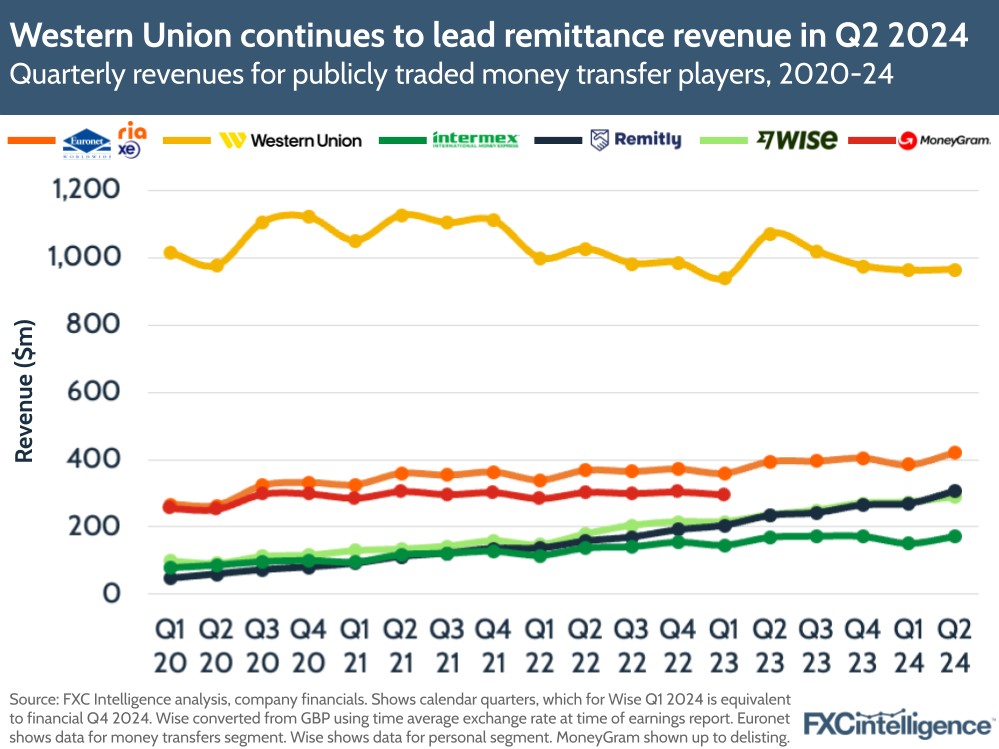
Key trends in net interest income
Interest income has been a subject of particular focus in recent quarters, as a result both of money transfer companies increasingly look to products that see them hold growing customer balances and of a period of historically high interest rates across multiple nations.
In its Q2 2024 quarterly report, Western Union reported net interest income of $3.7m, down from $4.2m in Q2 2023. While the company remains the leader in revenue for the companies we assess, the 11% decline in net interest income signals reduced earnings from holding customer funds, possibly due to higher competition.
By contrast, Remitly saw 42% net interest income growth in Q2 2024, increasing from $1.3m to $1.9m.
Notably, Euronet experienced an 68% increase in net interest income, rising from $3.5m to $5.9m in Q2 2024. The surge in Euronet’s net interest income speaks of improved management of liquidity and funds, as well as a larger customer base actively holding balances within its system.
However, in Q3 2024, we may see a reduction in net interest income across players as central banks lower interest rates and companies compete to maintain their customer balances.
In Wise’s recent trading update, the company reported its net interest income for Q3 24 had seen a 25% increase YoY, though this was a decline from 50% growth in Q2 24 and 370% in Q3 23.
Emphasis on digital transformation
In Q2, Western Union saw a 4% increase in consumer money transfers transactions, driven in part by 13% growth in Branded Digital transactions. Branded Digital revenue represented 24% of Western Union’s total consumer money transfers revenue in Q2 24, accounting for $231.6m.
Though Branded Digital’s share of C2C revenue has hovered around the low-20s since Q1 22, Q2 24’s 24% represents its largest share yet and comes as the segment has seen four consecutive quarters of revenue growth. As Western Union continues its Evolve 2025 strategy, a plan to stabilise and reinvent itself as a digital-led financial services provider, we could expect to see the Branded Digital segment growth further in Q3 and beyond.
To support the larger strategy, Western Union already introduced a new app homepage and a modernised user experience and interface in early 2024. In recent months, Western Union also expanded its digital presence across different regions, forming partnerships in China, the Philippines, Chile and West Africa. These partnerships have focused on improving customer experience and expanding digital services.
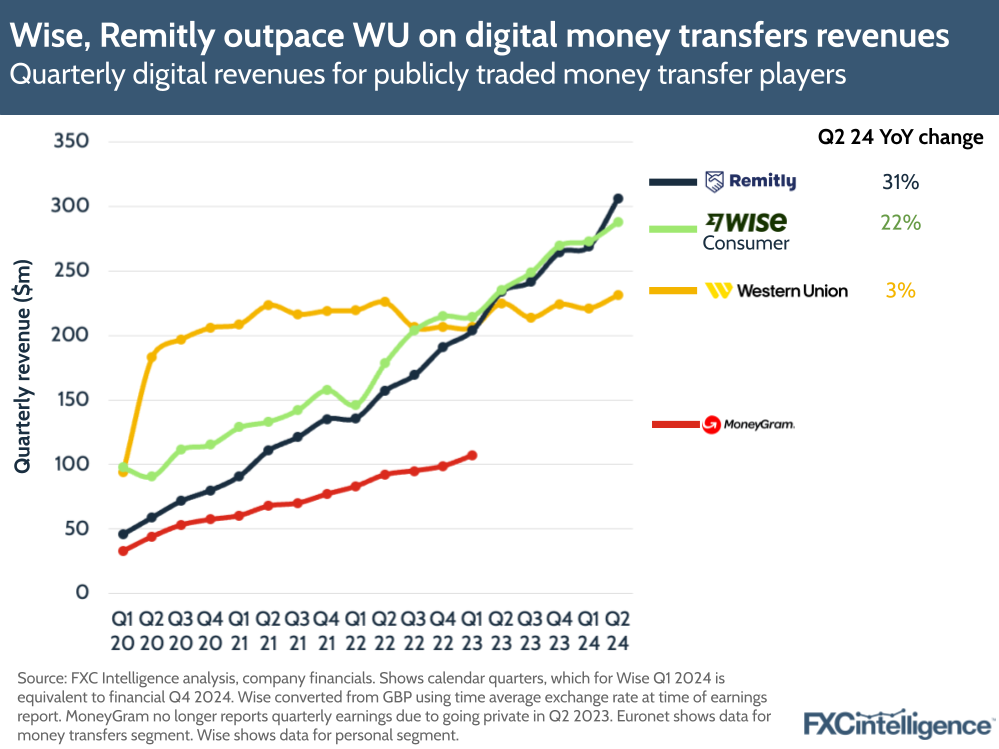
Despite these strategic moves, Western Union still falls behind when it comes to digital revenues, with only 3% YoY growth in Q2 2024.
Remitly, perhaps unsurprisingly given its solely digital focus when it comes to send, has shown consistent growth in digital money transfers revenue over the years, driven by key corridors such as the US-Mexico, US-Philippines and US-India. In Q2 24, it saw 31% growth to $306m.
Wise, meanwhile, saw a slight slowdown in its growth in Q2, though remaining positive at 22%, following a price cut implemented earlier this year.
Looking at how frequently ‘digital’ is mentioned in earnings calls, Intermex mentioned the term significantly more in Q2 2024 (76 times) than Q2 2023 (27), indicating the company’s growing emphasis on digital efforts.
In Q3 2024, we could expect tighter competition in the remittance space, particularly around digital strategies.
The question remains if Western Union can maintain its upward momentum in branded digital services, while Wise and Remitly continue their strong growth. At the same time, it remains to be seen how Intermex’s renewed focus on digital will translate into tangible performance results.
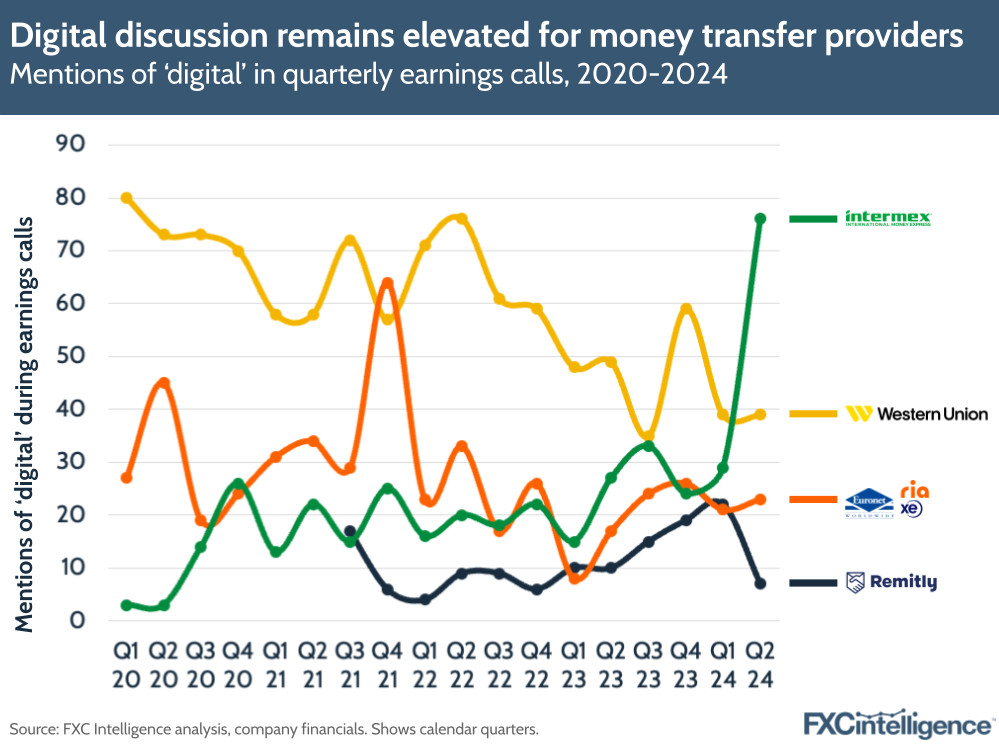
Regulatory frictions slowing remittances
For the remittance space, although revenues have been growing at a slower rate since Q1 2023 for several players, the majority of companies continue to maintain a positive outlook. Having said this, there have recently been a number of regulatory developments that could potentially impact Q3.
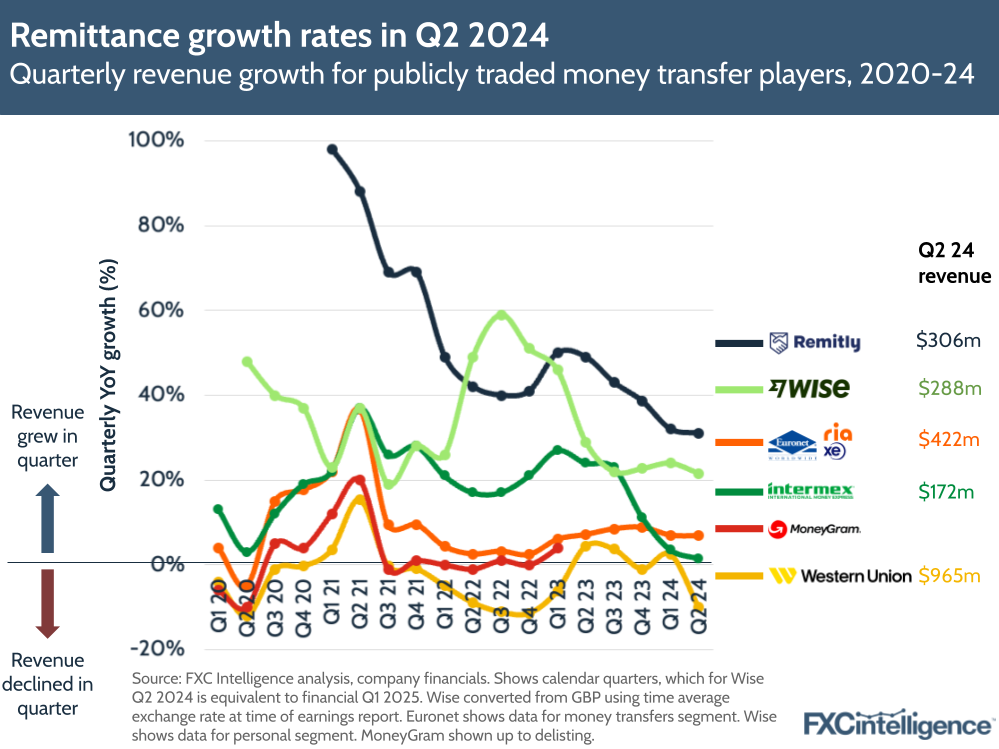
For example, Wise received a licence earlier in the year that allowed customers in India to send larger amounts of money, having previously been capped at $5,000 per transaction, but has also instituted a pause on accepting new clients while upgrading its infrastructure to comply with various rules for the new licence.
Meanwhile, Western Union suffered a suspension of services in Iraq in October of last year that, although reportedly cleared up as of December, appears to be part of ongoing regulatory uncertainty in the country affecting the company. This uncertainty, combined with earlier benefits from Central Bank of Iraq policy, created an unfavourable YoY comparison for Western Union as its revenue from Iraq dropped to $34m (-71%) in Q2 2024.
More recently, in October, the Financial Conduct Authority published a consultation paper on a safeguarding regime regulating UK e-finance institutions, including Wise. The regime aims to improve monitoring, reporting, fund segregation and implement a statutory trust, to protect consumer funds held in the UK. While this regime will not be implemented in any form for some time, we may see potentially affected companies make anticipatory changes to their operating procedures.
The impact of currency volatility
Recently, currency volatility has been on the rise, with J.P. Morgan’s measure of future currency volatility hitting its highest point since April 2023 in early October and further fluctuations in developing-nation currencies.
Euronet reported a $1.5m net foreign currency exchange gain in Q2 2024, compared to $6.3m in Q2 2023. This reflects Euronet’s reduced ability to capitalise on favourable exchange rate movements, with its core corridors in the US and LatAm countries not seeing the same benefits as other currency pairs.
Euronet also noted that it typically sees the highest demand for dynamic currency conversion services in Q3 of each year, which can be seen in peaks in its EBITDA margin.
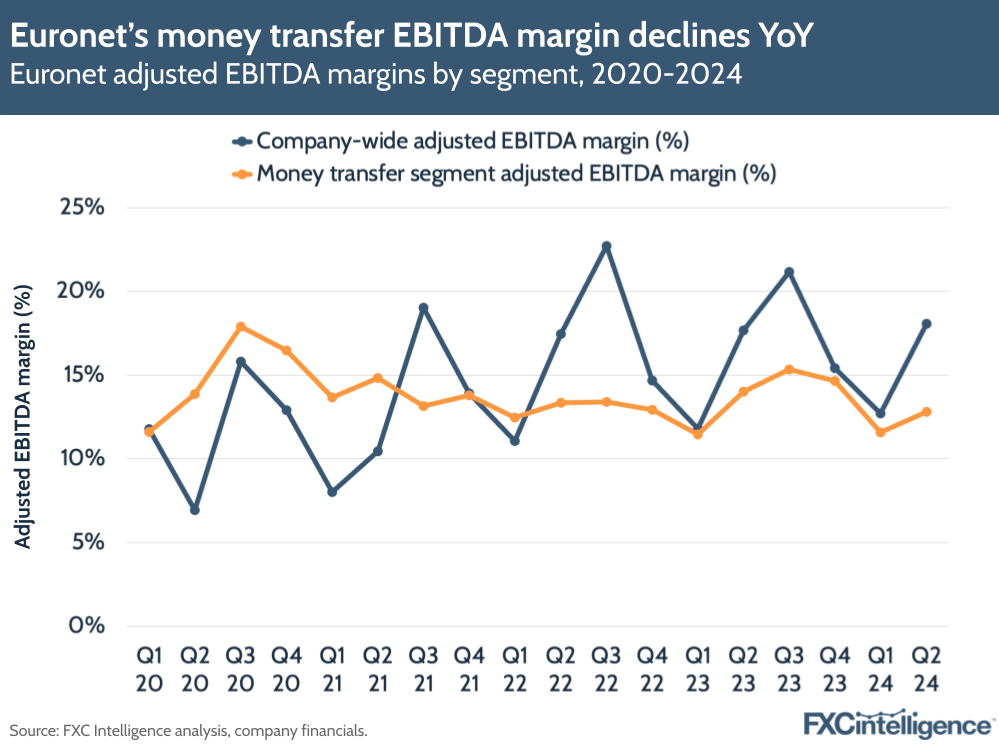
While Western Union reported a foreign currency translation impact of $0.3m in Q2 24, the majority of the regions only saw a 0% to 2% impact. The Branded Digital segment also saw a 2% impact from both foreign currency translation and inflation in Argentina, showing an improvement since Q2 2023.
These figures are linked to Argentina’s peso devaluation of 22% in August 2023. The devaluation was followed by a series of upward swings in the parallel exchange rate, with inflationary pressures persisting throughout 2024.
Wise mentioned currency volatility in its 2023 annual report, which covers March 2023 to March 2024, identifying it as a risk linked to weak global growth. The company regards it as a “market-wide stressor” that could impact major currency markets.
With the upcoming US election and ongoing geopolitical shocks, we could expect to see the further presence of currency volatility in Q3 earnings, as well as discussions around revenue stability and cost management.



